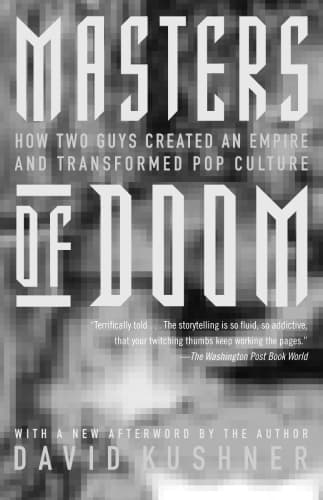Masters of Doom
The two Johns that defined my teenage gaming years.

Growing up in the 90s, id Software was synonymous with groundbreaking games – and parental concern (how did I get away with playing DOOM?!). David Kushner’s “Masters of Doom” (ISBN 9780749924898) dives into the origin story of this iconic studio, focusing on its founding duo: John Carmack, the programming prodigy, and John Romero, the rockstar designer. While I devoured the id Software classics like Commander Keen, Wolfenstein 3D, DOOM and Quake, this book revealed the depth of their influence on my gaming teenage years. While I knew about Carmack, shamefully, “Masters of Doom” filled the void with Romero’s story.
The book’s pacing, however, could be brisker. While details about their junk food and deathmatches offer some context, a deeper exploration of their innovations would have been welcome. What made sidescolling so grounbraking on PC when it was already done on consoles? Why was Carmack the first to make it work? Romero’s level design was top notch, but what made it so?
My teenage self remembers begging for a new graphics card to keep up with the latest games. This book captures my frustration, highlighting how far hardware has come since those days. Each generation seemed to usher in must-have innovations: the leap to super VGA, the introduction of 3D graphics, the power of dynamic lighting. Perhaps it’s just nostalgia clouding my judgment, but back then, these advancements felt truly epochal. Now, looking back through the lens of the book, I can appreciate the impact these early pioneers had.
However, the portrayal of the Johns felt a bit caricature-ish. Carmack as the anti-social programmer and Romero as the swearing rockstar – but were they really that one-dimensional? Makes you wonder how accurate the story really is. The book shines in highlighting how the magic in the collaboration between the two Johns likely played a significant role in their success than their (undeniable) individual talents alone.
One cool detail: I knew Carmack was related to Armadillo Aerospace, but this book explained how it started with him dabbling in rockets as a hobby. No wonder it pops up in gaming circles.
Though games were barely acknowledged as a legitimate form of expression, let alone a legitimate art form, Tom was convinced that they were almost sublime forms of communication, just as films or novels. — David Kushner, about Tom Hall
This quote resonated deeply. Back then, games still had to prove their worth. As I write this, watching the television adaptation of The Last of Us, it’s clear how things have changed. Today, we see an increasing number of television series based on video games, a remarkable shift from the days when games desperately sought legitimacy.
Overall, I enjoyed learning about this pivotal era in gaming and the people who fueled it. Thanks to them, my teenage years were filled with pixelated fun! Though the book feels a bit overrated in tech circles.